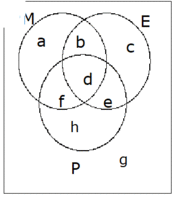A poll of 100 registered voters designed to find out how voters kept up with current events revealed the following facts.
How many of the 100 people surveyed used only one of the three sources listed to keep up with current events?
| 65 watched the news on television. |
| 39 read the newspaper. |
| 39 listened to radio news. |
| 20 watched TV news and read the newspaper. |
| 27 watched TV news and listened to radio news. |
| 9 read the newspaper and listened to radio news. |
| 6 watched TV news, read the newspaper, and listened to radio news. |
How many of the 100 people surveyed used only one of the three sources listed to keep up with current events?

